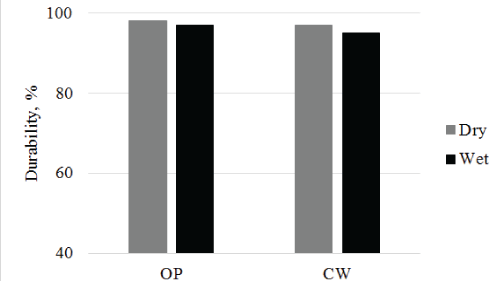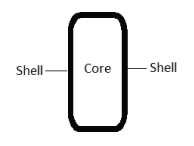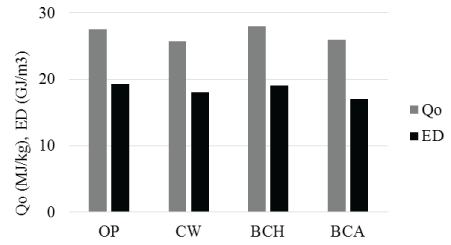High-Energy Fuel Pellets
Michael Ioelovich1*
1Celdesigner Energy Ltd, Rehovot, Israel.
*Corresponding Author: Michael Ioelovich,Celdesigner Energy Ltd, Rehovot, Israel, Tel: +972-54-783-9007; Fax: +972-54-783-9007; E-mail: ioelovichm@gmail.com
Citation: Michael Ioelovich (2020) High-Energy Fuel Pellets. SciEnvironm 3: 147.
Copyright: © 2020 Michael Ioelovich, et al. This is an open-access article distributed under the terms of the Creative Commons Attribution License, which permits unrestricted use, distribution, and reproduction in any medium, provided the original author and source are credited.
Received: June 02, 2020; Accepted: June 15, 2020; Published: June 19, 2020.
Abstract
The purpose of this study was to obtain high-energy pellets from natural biomass sources with improved fuel properties and durability. Two biomass types, namely residues of mixed coniferous wood and olive pomace, were selected as feedstock for this purpose. It was found that olive pomace is a promising natural source for the production of fuel pellets. The chosen biomasses were used for pelletization along with auxiliary materials, such as starch, synthetic rubber (SBR) and polyethylene waste (PEW). The milled biomass samples and their mixtures with binders were compacted under increased pressure and temperature, and then cooled. Besides, part of the pellets was coated with layer of hydrophobic agent, such as melt of PEW. The pellets were studied by methods of calorimetry, water vapor sorption and durability testing. The results have shown that fuel characteristics of the pellets containing starch binder were lesser than those of coals; moreover both fuel properties and durability of these pellets were reduced after sorption of water vapor. The use of hydrophobic binder (SBR) improves durability of the pellets, whereas the additional coating with PEW layer allows obtaining the especial high-quality pellets with high fuel properties and high durability both in dry and wet state. As a result, the energetic features of these especial solid biofuels become comparable with those of fossil coals.
Keywords
Biomass, Fuel Pellets, Heat of combustion, Density of Thermal Energy, Durability
Introduction
Currently, the main solid fuel is fossil coal, which provides 28-30% of annual energy consumption in the world, about 160-180 EJ [1]. To generate such energy, more than 6 billion tons of coal are burned each year. However, this fossil source of energy is not reproduced in nature, and therefore its reserves are permanently depleted. Besides, the burning of coal is accompanied by emission of greenhouse gas - carbon dioxide, in the huge volume of 1700-1800 m3 from each ton, which can exacerbate the problem of global warming [2].
An alternative to coal can be solid fuels based on plant biomass, which in contrast to fossil fuels, are reproduced in nature. The term “biomass” means here a variety of plant materials, as well as their residues and wastes [3]. As is known, monosaccharides are photosynthesized in chlorophyll pigment of plant leaves from carbon dioxide and water, absorbing red and blue-violet sunlight [4,5]. Then, the biosynthesis reactions occur in the plant cell walls, as a result of which the monomeric sugars are transform?d into polysaccharides (cellulose, hemicellulose, starch, pectin, etc.), lignin, waxes, resins, vegetable oil and other components of biomass. In fact, plant biomass can be considered an accumulator of solar energy. To generate the heat energy, the biomass is burned, resulting in the release of accumulated solar energy. A specific feature of the biomass that it is neutral for emission of carbon dioxide, since its combustion produces the same amount of this greenhouse gas as it was absorbed from the atmosphere during photosynthesis. Total biomass resources, which can be used for direct burning or producing of liquid and gaseous biofuels, are estimated at 8-10 billion tons [6].
However, the plant biomass is a heterogeneous material of low bulk density, which consists of pieces of different shapes, sizes and compositions. The bulk density of the biomass varies from 40-80 kg/m3 (grasses), to 150-200 kg/m3 (wood chips), whereas the energy density is relative low, from 0.5 to 5 GJ/m3. Besides, the natural biomass is usually wet containing from 10 to 55% of moisture. Some biomass types, such as rice straw or husk, packaging and printing papers, can contain from 15 to 30% of inorganic components. These negative features of the plant biomass leads to deterioration in fuel properties during direct burning – low and unstable calorific value, low density of thermal energy and insufficient combustion efficiency [7].
On the other hand, such energetic components as lignin and organic extractives (waxes, resins, lipids, etc.) boost the calorific value of biomass [2,8]. Thus, in order to improve the energy potential of solid biofuels, firstly it is necessary to choose the biomass with enough high content of energetic components, as well as with small content of inorganic admixtures and moisture. Secondly, to increase the small energetic density, the loose biomass may be converted into dense pellets. Pelletization of the plant biomass is a well-known process, which includes a number of steps: selection, removal of foreign pieces and materials, drying to a moisture content of 10%, shredding, grinding to particle size of 1 to 3 mm, hot pressing into pellets [9]. Addition of binders (e.g. starch) to biomass before compacting improves the durability of pellets. Currently, the fuel pellets are produced from residues (sawdust, chips) of coniferous wood specifies, mainly from pine and spruce having an increased content of lignin [10]. However, the yield of these residues is small (<10%), which hinders the further production expansion of such pellets. This is one of the reasons, why the global annual production of fuel pellets is low, 28-30 million tons [11]. To expand the base of raw materials for the production of fuel pellets, the search of alternative biomass source is needed.
Another problem of fuel pellets is that they are hydrophilic, and therefore their properties deteriorate after storage in the atmosphere of humid air. Since the starch binder is also hydrophilic, its presence does not contribute to the preservation of properties of fuel pellets during storage. The solution to this problem can be the use of a hydrophobic binder, as well as a protective hydrophobic coating. Available, cheap and importantly combustible hydrophobic material can be synthetic rubbers, e.g. styrene-butadiene rubber (SBR), which produces in an amount of 8 million metric tons [12]. Other widespread, cheap and combustible hydrophobic material is waste of polyethylene (PEW), which annually accumulates in nature in huge amounts of 2 billion tons and pollutes the environment [13]. These hydrophobic materials can be used as promising additives to improve properties of fuel pellets. The main purpose of this study was to find an alternative non-wood biomass source, as well as to obtain especial high-quality pellets with improved fuel properties and durability.
Experimental
Biomass samples: Two types of biomass were used: (1) common feedstock such as chips of mixed coniferous (pine and spruce) wood and (2) alternative feedstock, namely olive pomace. The biomass samples were cut, knife-milled and screened through a sieve to obtain the fraction of 1 mm and then conditioned to moisture content of 10%.
Auxiliary materials: Some other materials were used for pelletization, such as potato starch, latex of synthetic rubber (SBR) and polyethylene waste (PEW).
Pelletization: The milled biomass samples and their mixtures with binders (starch or SBR) were compacted under pressure 150 MPa at temperature of 100oC. Besides, part of the pellets was coated with a melt of PEW at 150oC and then cooled.
Study of chemical composition: The chemical composition of the biomass samples was determined by conventional methods of chemical analysis [2].
Combustion calorimetry: Combustion of dehydrated samples (cca. 1 g) was carried out in a bomb calorimeter Parr-1341 at oxygen pressure of 3 MPa with 1 ml of added deionized water. The temperature and its rise (ΔT) were measured with accuracy ±0.001 K. The value of energy equivalent of the calorimetric system (C) was determined by combustion of standard benzoic acid. To calculate the specific energy of combustion (Q), the needed correction for ignition (e1), as well as for formation and dissolution of nitric and sulfuric acids (e2) were taken into account:
Q = (CΔT – e1 – e2)/m (1)
where m is true mass of sample.
To obtain the standard value of specific energy of combustion (Qo) the Washburn’s correction was introduced.
Furthermore, the density of thermal energy (ED) was calculated as follow:
ED = Qo x d (2)
where d is bulk density of the pellets (kg/m3)
Sorption of water vapor: The pellets were kept at 25oC in a desiccator having relative humidity (RH) of 85% to constant weight. The percentage of sorbed water (S) was calculated as follows:
S = 100% [(W/Wo) -1] (3)
where W and Wo is weight of wet and dry sample, respectively.
Testing of durability: Durability of the biomass pellets was measured in accordance with ISO 17831-1 [14]. For each sample three experiments were performed to obtain the reliable value of durability.
Reliability: For each sample three experiments were performed to obtain the reliable result.
Results and Discussion
Study of chemical composition of selected biomass types showed that olive pomace (OP) contains more energetic components (lignin, organic extractives) than sample of mixed coniferous wood (CW), which is a conventional feedstock for the production of fuel pellets (Table 1). As a result, the dry pellets made from OP with additive of starch binder have better fuel properties (Table 2).
Table 1: Percentage of main components of biomass samples*
|
Biomass |
Cellulose |
Hemi |
Lignin |
OE |
Ash |
Others |
|
CW |
48 |
20 |
27 |
3 |
1 |
1 |
|
OP |
24 |
26 |
32 |
11 |
3 |
4 |
*Note: Hemi denotes hemicelluloses; OE denotes organic extractives
Table 2: Fuel characteristics of biomass pellets containing 10% starch binder*
|
Biomass |
Binder |
Qo, MJ/kg |
ED, GJ/m3 |
|
CW |
Starch |
20.14 (19.22) | 12.10 (10.57) |
|
OP |
Starch |
22.73 (20.32) | 13.64 (11.18) |
*Note: the fuel characteristics in humid conditions are shown in brackets
However, fuel characteristics of the pellets containing starch binder were lesser than those of coal samples with Qo = 25-30 (MJ/kg), ED = 17-20 (GJ/m3) [15]. Significant shortcoming of these fuel pellets is their hydrophility. Therefore, after storage of the pellets in the humid atmosphere (RH=85%), there is an appreciable decrease in fuel characteristics (Table 2) and durability (Figure 1) is observed.
Figure 1: Durability of dry and wet pellets containing starch binder.
The further studies have shown that the use of hydrophobic binder, SBR, instead of hydrophilic starch in amount of 10% improves durability of the pellets both in dry and wet state (Figure 2).
Figure 2: Durability of dry and wet pellets containing 10% SBR as binder.

However, the use of small amount of hydrophobic binder only slightly improves the fuel properties of the pellets after storage in atmosphere of humid air. To prevent sorption of water vapor and enhance the durability and fuel properties of solid biofuel, the fuel pellets containing hydrophobic binder were additionally coated with hydrophobic melt of PEW having an increased calorific value, Qo = 43 MJ/kg [16-18]. Thus, especial pellets (EP) have the core-shell architecture (Figure 3), where the core contains compacted biomass and hydrophobic binder, whereas the shell consists of hydrophobic and combustible plastic.
Figure 3: Core-shell architecture of especial pellets.

These especial pellets are characterized by low hydrophility, high durability in dry and wet conditions (Figure 2), as well as by high fuel properties (Table 3, Figure4).
Table 3: Fuel characteristics of especial pellets*
|
Biomass |
Binder |
Shell |
Qo, MJ/kg |
ED, GJ/m3 |
|
CW |
SBR |
PEW |
25.73 (25.52) |
18.01 (17.90) |
|
OP |
SBR |
PEW |
27.52 (27.20) |
19.26 (19.04) |
*Note: the fuel characteristics in humid conditions are shown in brackets
As a result, the energetic features of especial pellets become comparable with those of fossil coals (Figure 4).
Figure 4: Energetic features of especial pellets in comparison with bituminous coal of high quality (BCH) and average quality (BCA).

Conclusions
It was found that olive pomace can be a promising alternative natural source for the production of high-quality fuel pellets. The fuel pellets made from plant biomass and hydrophilic starch binder have an increased hydrophility. As a result, after storage of these pellets in the humid atmosphere, an appreciable decrease in fuel characteristics and durability was found. The use of hydrophobic binder instead of hydrophilic starch, promotes to obtaining improved pellets having high durability in dry and wet conditions; however, only slight improvement of the fuel properties of these pellets in the wet conditions was observed.
To significantly increase the various features of the solid biofuel, the core-shell architecture for especial biomass-based pellets was proposed, where the core contains compacted biomass and hydrophobic natural binder, whereas the shell consists of hydrophobic and combustible plastic. As a result, the hydrophobity and durability of the fuel pellets increases, whereas energetic features of these solid biofuels become comparable to those of fossil coals.
References
- Ioelovich M (2013) Plant biomass as a renewable source of biofuels and biochemical. Saarbrücken : LAP, 52 p.
- Ioelovich M (2015) Recent findings and the energetic potential of plant biomass as a renewable source of biofuels – a review. Bioresources 10: 1879-1914.
- Saidur R, Abdelaziz EA, Demirbas A, et al. (2011) A review on biomass as a fuel for boilers. Renew. Sust. Energy. Rev. 15: 2262–2289.
- Raven PH, Evert RF, Eichhorn SE (2005) Biology of plants. New York: W.H. Freeman and Company, 686 p.
- Blankenship R E (2014) Molecular mechanisms of photosynthesis. Oxford: John Wiley & Sons, 312 p.
- Parikka M (2004) Global biomass fuel resources. Biomass and Bioenergy27: 613-620.
- McKendry P (2002) Energy production from biomass: overview of biomass. Biores. Technol83: 37-46.
- Dhamodaran A, Afzal M (2013) Modeling and characterization of reed canary grass pellet formation phenomenon. Int. J. Renew. Sustain. Energy2: 63-73.
- Stelte W, Sanadi AR, Shang L, et al. (2012) Recent developments in biomass pelletization - a review. Bioresources 7: 4451-4490.
- Rominiyi OL, Adaramola BA, Ikumapayi OM, et al. (2017) Potential utilization of sawdust in energy, manufacturing and agricultural industry. World J. Eng. Technol 5: 526-539.
- Global forest production: facts and numerals. Report of FAO, 2016. 20 p.
- Garside M (2019) Global production capacity of styrene-butadiene-rubber 2018 & 2023. Statista, Nov. 6.
- Geyer R, Jambeck JR, Laws KL (2017) Sci. Adv 3: 1-5.
- ISO 17831-1. Solid biofuels - determination of mechanical durability of pellets and briquettes. London: The British Standards Institution, 2015, 10 p.
- Mahapatra D (2016) American Int. J. Res. in Sci. Techn., Eng. & Mat., 14: 57-68
- Walters RN, Lyon RE, Hackett SM (2000) Heats of combustion of high-temperature polymers. Fire and Mater 24: 1-13.
- Ioelovich M (2018) Energy potential of natural, synthetic polymers and waste materials - a review. Acad. J. Polymer Sci 1-15.
- Ioelovich M (2018) Thermodynamics of biomass based solid fuels. Acad. J. Polymer Sci 2: 1-7.
